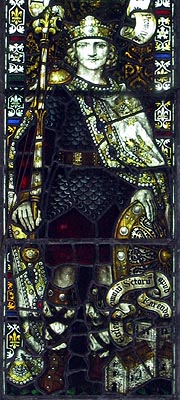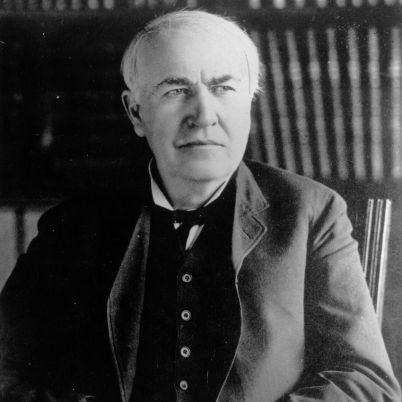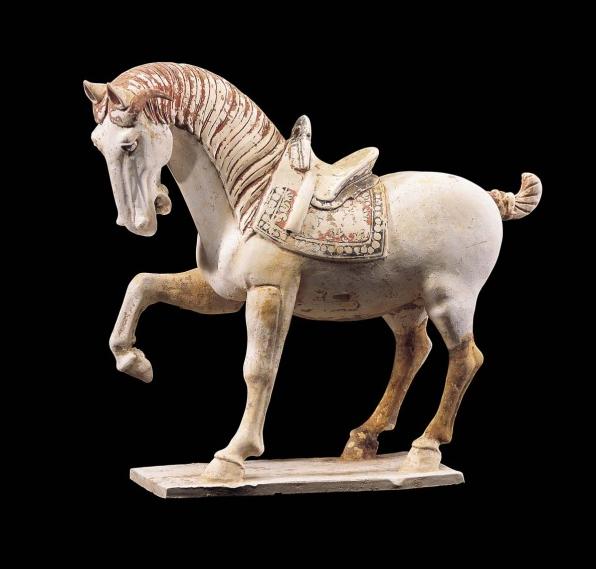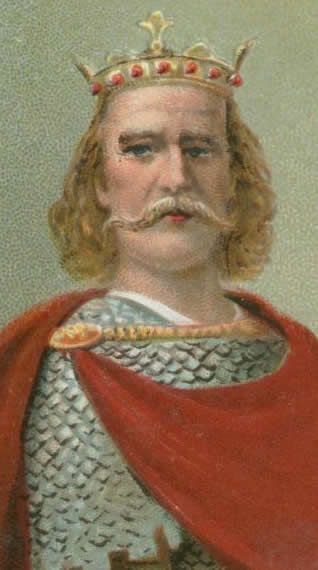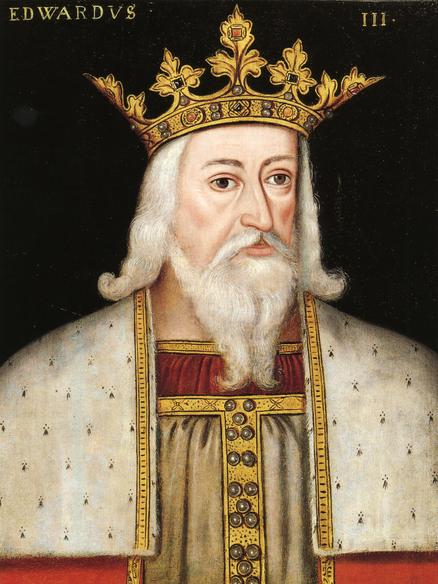Name: King Edward The Elder
Born: c.871
Parents: Alfred the Great and Ealswith of Mercia
Relation to Elizabeth II: 31st great-grandfather
House of: Wessex
Crowned: June 8, 900 at Kingston-upon-Thames, aged c.29
Married: (1) Ecgywn (2) Elfleda and (3) Edgiva.
Children: 5 sons and 11 daughters
Died: July 17, 924 at Farndon-on-Dee
Buried at: Winchester
Succeeded by: his son Aethelstan
King of the West Saxons. He succeeded his father Alfred the Great in 899. He reconquered southeast England and the Midlands from the Danes, uniting Wessex and Mercia with the help of his sister Aethelflaed. By the time of his death his kingdom was the most powerful in the British Isles. He was succeeded by his son Athelstan.
Edward extended the system of burghal defence begun by Alfred, building new burhs, for example at Hertford and Buckingham, and twin burghs at Bedford and Stamford
During the reign of his father Alfred the Great, Edward the Elder had taken an active role in his campaigns against the Vikings. On the great Alfred’s death the succession was disputed between Edward or Eadweard and Ethelwald, the son of Alfred’s elder brother Ethelred I . The Witan elected Edward as King.
Ethelwald reacted by seizing the crown estates at Wimborne and Christchurch. Edward was quick to respond to the threat, but his cousin escaped and sought refuge with the Vikings of Northumbria. He returned in 905 at the head of an army, battle ensued at Holme in Essex, during the course of which Ethelwald himself was killed, but the Danes eventually emerged the victors. Edward escaped the battlefield unhurt and later negotiated a treaty with his enemies.
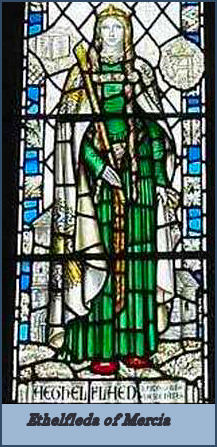 The treaty was broken on the arrival of Reginald, son of Guthred, in Northumbria, who quickly captured the city of York and occupied the northern kingdom of Bernica. At the same time, Mercia was yet again invaded, the Danes advancing as far as the Severn. Edward, leading a joint force from Wessex and Mercia, again encountered them in battle at Tettenhall in Staffordshire and on this occasion won a decisive victory.
The treaty was broken on the arrival of Reginald, son of Guthred, in Northumbria, who quickly captured the city of York and occupied the northern kingdom of Bernica. At the same time, Mercia was yet again invaded, the Danes advancing as far as the Severn. Edward, leading a joint force from Wessex and Mercia, again encountered them in battle at Tettenhall in Staffordshire and on this occasion won a decisive victory.
Along with his sister Aethelflaed, Lady of Mercia, the widow of King Ethelred of Mercia, who was known as the Lady of Mercia, Edward spent most of the early part of his reign engaged in the intermittent conflict with the Vikings. Ethelfleda embarked on a policy of fortifying towns against the Danes. A true daughter of Alfred the Great, she defeated them in battle in Wales, from where they had threatened Mercia’s western border. Edward slowly gained ground against the Danes, eventually pushing the boundaries of Wessex and Mercia northwards.
Following his sister’s example, the King secured his re-conquests by building strong fortifications to defend them. London and Oxford were turned into strong garrisons to support King Edward’s campaign against the Danes.
The British princes, including Howel the Good, Prince of Wales, or Wealas (Anglo-Saxon for foreigner) and Cledauc accepted Edward the Elder as their overlord. In the year 920, the Kings of the North, including Sigtrygg Caech (the squinty), Constantine II, King of Scots and Donald Mac Aedh, King of Strathclyde, met King Edward at Bakewell in Derbyshire, fully recognising his overlordship.
Edward also reorganized the Church in Wessex, creating new bishoprics at Ramsbury and Sonning, Wells and Crediton.
The first mention of Edward’s eponym the Elder occurs in the tenth century, when it was used in Wulfstan’s Life of St Æthelwold, to distinguish him from the later King of the same name, Edward the Martyr.
Unusual for a member of the House of Wessex, Edward does not seem to have been a particularly devout son of the church. On the contrary, the church in Wessex appears to have been neglected in his reign, leading the Pope to deliver a reprimand to the king.
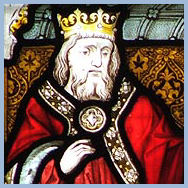 His sister Ethelfleda died in 920 and her daughter and heiress, Elfwina, suceeded to the province, she became known by the title her mother formerly had held, the Lady of Mercia. Elfwina in turn recognised her uncle, Edward, as her overlord. Although Mercia and Wessex remained two separate territories, they were now united under the same ruler.
His sister Ethelfleda died in 920 and her daughter and heiress, Elfwina, suceeded to the province, she became known by the title her mother formerly had held, the Lady of Mercia. Elfwina in turn recognised her uncle, Edward, as her overlord. Although Mercia and Wessex remained two separate territories, they were now united under the same ruler.
Edward had a total of 14 children by 3 consorts. Ecgwynn or Ecgwynna, who may have been his wife or concubine, it is not certain which, some sources describe her as a ‘common law wife’, Ecgwynn may have been related to St Dunstan. She produced a son, Athelstan, who succeeded his father as King of England and a daughter Edith, who became Queen of Dublin. He later married Elfflaed, who was the daughter of an ealdorman Ethelhelm, presumed to be ealdorman Ethelhelm of Wiltshire who died in 897, although some historians identify Elfflaed’s father as Ethelhelm, the son of Edward’s uncle, King Ethelred I of England. This marriage produced a further 8 children, Elfweard of Wessex, Edwin, Eadgifu, the second wife of King Charles III of France, Eadhild, Duchess of the Franks, Eadgyth, wife of Otto I, Holy Roman Emperor, Elfgifu, Eadflæd and Eadhild of Wessex. Finally he married Edgiva or Ediva of Kent, daughter of Sigehelm, Ealdorman of Kent, who was killed at the Battle of the Holme in 902. They had 4 children, Edmund the Elder, who succeeded his half-brother Athelstan as King of England, Edred, King of England, Saint Eadburh of Winchester and Eadgifu of Wessex.
Edward the Elder died while leading an army to combat a Cambro-Mercian rebellion, on 17 July 924 at Farndon-on-Dee, Mercia, his body was buried at the the New Minster at Winchester, which Edward himself had established. Following the Norman conquest, the minster was replaced by Hyde Abbey and King Edward’s body was transferred there. His grave is currently marked by a cross-inscribed stone slab within the outline of the old abbey marked out in a public park.
He was succeeded by his eldest son, Athelstan whom he had named as his heir.
The family of Edward the Elder
Edward was married three times, in all begetting 18 children. His first wife, whom he married around 893, was Egwina, a noblewoman. William of Malmesbury, writing in the twelfth century, informs us that her children, including Athelstan, who succeeded his father, were illegitimate, however this is unlikely as Athelstan ascended to the throne as undisputed King after the death of his father. Their three children were:-
(1) ATHELSTAN, KING OF ENGLAND b. 894
(2) Alfred
(3) St. Edith
Edward was married secondly, to Elfleda, who was the daughter of Ethelhelm, ealdorman of Wiltshire, this second marriage produced ten children :-
(4) Elfweard
(5) Edgifu b. 902
(6) Edflaed, a nun at Wilton Abbey
(7) Edwin, sub-king of Kent
(8) Elflaeda, a nun at Winchester
(9) Ethelflaeda, Abbess of Romsey
(10) Edhilda
(11) Edith
(12) Ethelhild
(13) Elgifu
Edgifu, daughter of Sigehelm, Ealdorman of Kent, was to become the King’s third wife in about 905. They produced a further four children :-
(14) Edgifu
(15) St. Elburga, a nun at Nunnaminster
(16) EDMUND THE ELDER, KING OF ENGLAND b. circa 921
(17) EDRED, KING OF ENGLAND, b. circa 924
Edward is also reputed to have fathered an illegitimate son, Gregory, Abbot of Einsiedlen.
| Timeline for King Edward The Elder |
| 900 | Edward the Elder, son of Alfred, crowned at Kingston-upon-Thames |
| 901 | Edward the Elder takes the title “King of the Angles and Saxons” |
| 902 | Eric, ruler of the Danes in East Anglia, dies in the Battle of Holme |
| 910 | Reconquest of Danelaw lands begins. The last great Viking army sent to ravage England is defeated by an army of Wessex and Mercia. |
| 913 | Edward the Elder recaptures Essex from the Danes |
| 915 | Edward is accepted as overlord by Ragnald ruler of the Viking Kingdom of York |
| 916 | Edward’s sister Aethlfleda of Mercia attacks and conquers most of Wales |
| 916 | Vikings establish settlements at Dublin and Waterford in Ireland |
| 918 | Edward becomes ruler of Mercia following the death of his sister Aethlfleda |
| 920 | Edward takes East Anglia from the Danes |
| 923 | The Scottish King Constantine II submits to Edward |
| 924 | Edward dies at Farndon-on-Dee near Chester leading an army against the Welsh. He is buried in Winchester. |
Credits:
http://www.britroyals.com/
http://www.englishmonarchs.co.uk/

